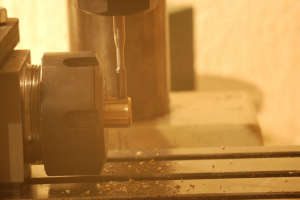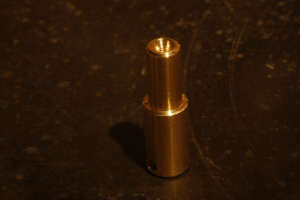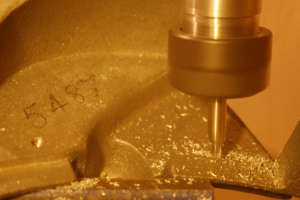
Presto 75A: 50 Hz 33 1/3 and 45 rpm Conversion
It would appear that 50 Hz conversions of vintage "made in USA" disk recording lathes are becoming rather fashionable! Last week we examined how we converted a Rek-O-Kut Model V by machining a new capstan and making a special transformer, Type 1760.

We have done 50 Hz conversions (and even some 60 Hz ones!) on many different lathes and turntables, using all of the possible methods of doing so: New rubber rollers, new capstans, new belt pulleys and even electronic frequency conversion (Agnew Analog Type 191 frequency converter) for professional disk mastering systems.
This week, we will have a look at the Presto 75A, a high quality machine, dating from the 1930's, which was even used by the BBC as a broadcasting turntable!

It is powered by a 60 Hz Westinghouse synchronous AC motor. The capstan sleeve on the motor shaft engages the rim of the platter directly, as a single-step reduction, friction drive system. This arrangement is often referred to as "rim-drive". However, it is usually a rubber roller on the motor shaft engaging the metallic rim of the platter.
The 75A is arranged the other way around!
The capstan is metallic and the platter has a rubber wheel all around the rim!
Easier to convert that way, or so we thought!

This is a two-speed setup, 33 1/3 and 78 rpm. The capstan is stepped, with the smaller diameter engaging the rim for 33 1/3 and the larger for 78 rpm. The lever mechanism is of substantial construction, obviously intended for heavy duty use.
First step, as we did for the Model V, was to machine a suitable drift pin to extract the original capstan without damage. A custom puller plate is used with an extractor.

An interesting detail is that the original capstan had a set-screw on the side, which was extremely tight. However, the capstan is a press-fit on the shaft, which does not normally need a set-screw. Even with the set-screw removed, the capstan won't budge. It is a proper interference fit, and a rather tight one at that. Moreover, the capstan is made of steel! Nobody installs screws where they are not needed, and nobody makes tight press-fits with steel parts on purpose, with no good reason, so by this point, J. I. Agnew was getting suspicious.

The motor shaft has a flat on one side, which is not the ideal situation for a press fit. Careful measurements confirmed the suspicions: The flat is not very accurately formed! It is not entirely parallel to the shaft. It is deeper at front and shallower at the back. Good luck trying to get anything to run true on that!

Geometric shapes were being frantically rotated in Mr Agnew's brain, in search of a good solution.
To add to the difficulties, the diameter of the motor shaft was a highly non-standard value, meaning that a slow and measurement-heavy machining job would ensue.


It was decided to machine the new 50 Hz capstan from our favorite "capstan brass" alloy, making it a light interference fit and adding some special features to ensure true running. In addition, it was decided to convert it to 33 1/3 and 45 rpm, since 78 rpm is no longer in common use. We have done 78 to 45 rpm conversions on other machines in the past, so this one was easy.

The partly finished 50 Hz capstan is shown next to the original, 60 Hz capstan for comparison. The length was reduced, as one of the measures to assist with true running. The new capstan was pressed onto the motor shaft before any of the additional features were machined, to test the fit. It was a good light press as intended, and ran ever-so-slightly out of true, due to the inaccurate flat. It was not visible to the eye, but caused audible noise and was measurable with a dial indicator. So, it was pulled out again to finish.
During the first machining run, a small pilot hole was machined all the way through. Now this hole was tapped accurately and a hole on the side was drilled and tapped for a set-screw.




The master plan was a more accurate version of the original Presto concept. The motor shaft had been center drilled, to mount between centers for grinding accurately. The flat, however, was made on a different machine. The setup was less than ideal, introducing a parallelism error which was probably deemed insignificant for most applications at the time. Westinghouse had not designed this motor for lathes, it was a general purpose motor which also found application in the 75A. Now, this is where an engineering background and a good understanding of (and experience with) manufacturing operations comes in handy: While the flat is inaccurate, the centers are is a highly accurate point of reference for the round part of the shaft. Since the complete round shaft is not available due to the flat, we shall have to make do with the center hole as a datum and bearing point.
As it is in the form of a 60 degree cone, we simply need to machine a matching 60 degree center on the front of a stainless steel set-screw and use this to align the capstan to perfection!

The finished capstan is now pressed on to the shaft, the set-screw on the side tightened to a precisely calculated torque to compensate against forces which would cause deformation due to the flat on the shaft (using Hertzian Theory and Hooke's Law) and the center-screw tightened to bear against the center hole, made 90 years ago by Westinghouse as part of their motor manufacturing operations, thereby providing an accurate bearing against the deformation forces which would otherwise throw the capstan out of true.


Success! The capstan now runs true and within 0.00003" of calculated dimensions, delivering a quiet and near-perfect 33 1/3 and 45 rpm platter speed. Next step was to adjust the switch powering the motor, which is activated by the pivoted motor base approaching the rim, and the adjuster screws limiting the pressure with which the capstan engages the rim of the platter.



With all this done, time to refit all the decorative parts. Looks good.
Does it still work?
Try 33 1/3 rpm, all good.
Try 45 rpm ........ $!*~#%! (see "Reference Book of High-Level Profanities for Engineers", 2nd ed., p 243)!
Just when you think you are really smart, having solved a complicated problem, this is exactly when the simplest things go wrong, because you were too busy thinking about the complicated stuff and forgot to pay attention to the simple details...!
The aluminum casting forming the decorative lid that goes over the motor assembly has some angled steps on the underside, which make casting easier and are normally out of the way. However, with the 45 rpm capstan diameter being considerably smaller than the 78 rpm the machine was originally designed for, the motor base moves much further towards the platter, and now stops against the underside of the lid before even engaging the rim!
Not a biggie, just needs some engineer's blue on the lid to be able to see exactly where the offending part is, and then thin it out a bit on the milling machine.


Fortunately, there's plenty of material there. Only around 2 mm needed to be removed. The trickiest part was to figure out a good setup to rigidly mount this casting on the machine table.
The job was completed cleanly and nobody will ever notice it was done! Now everything works as it should, even at 45 rpm, and the original appearance of the machine has been preserved!

A full restoration of the 75A will follow soon, along with more lathe exotica...! Stay tuned!
